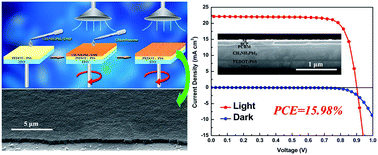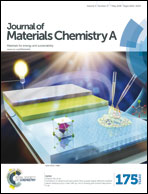Formation of ultrasmooth perovskite films toward highly efficient inverted planar heterojunction solar cells by micro-flowing anti-solvent deposition in air†
Abstract
Ultrasmooth perovskite thin films are prepared by a solution-based one-step micro-flowing anti-solvent deposition (MAD) method carried out in air with simplicity and practicability. Engaging inert gas blow and anti-solvent drips as accelerators, ultrafast crystallizing, thickness controllable, and high quality methylammonium lead iodide films are prepared with a least root mean square roughness of 1.43 nm (1.95 nm on average), achieving the smoothest surface morphology to the best of our knowledge, as well as a rather compact perovskite layer with a high coverage ratio. Perovskite films formed from MAD require no annealing procedure to ultimately crystallize, realizing a very fast crystallizing procedure within few seconds. By controlling the thickness of perovskite films, superior photovoltaic performance of solar cells with a large fill factor of 0.8 and a PCE of 15.98% is achieved without a glovebox. MAD technology will benefit not only highly efficient photovoltaic devices, but also perovskite-based hybrid optoelectronic devices with field effect transistors and light emitting diodes as well.


 Please wait while we load your content...
Please wait while we load your content...